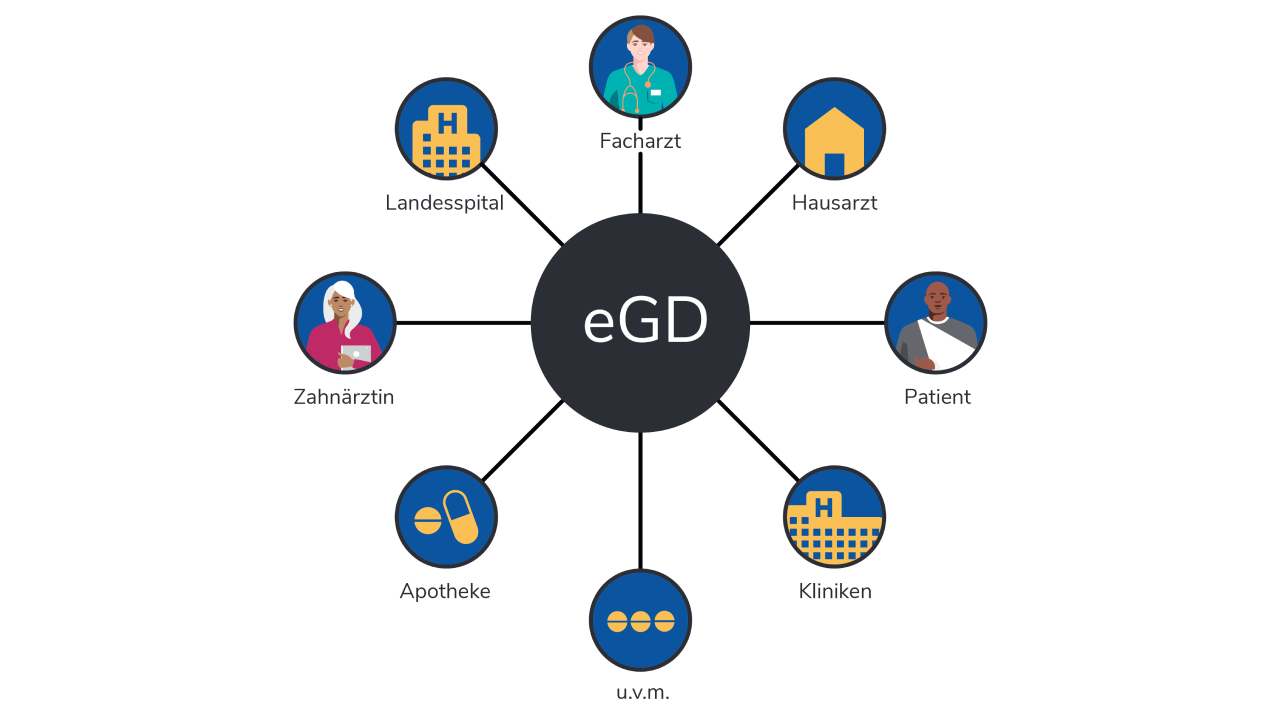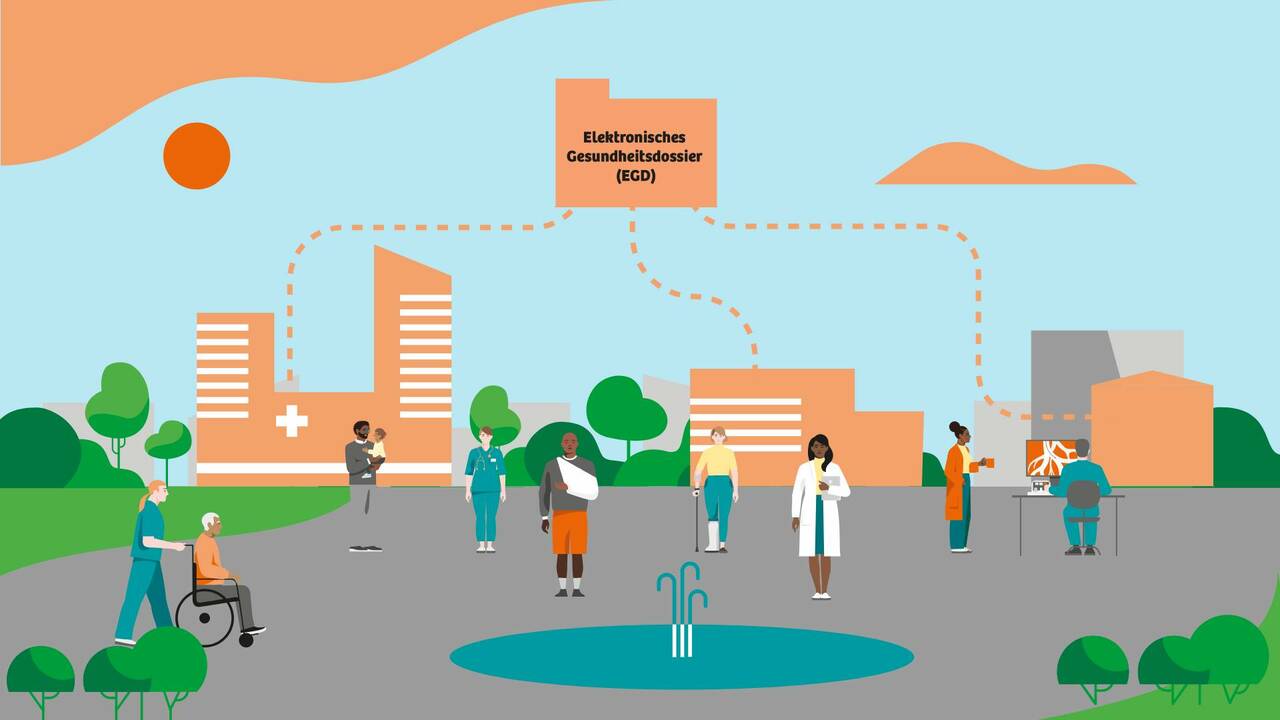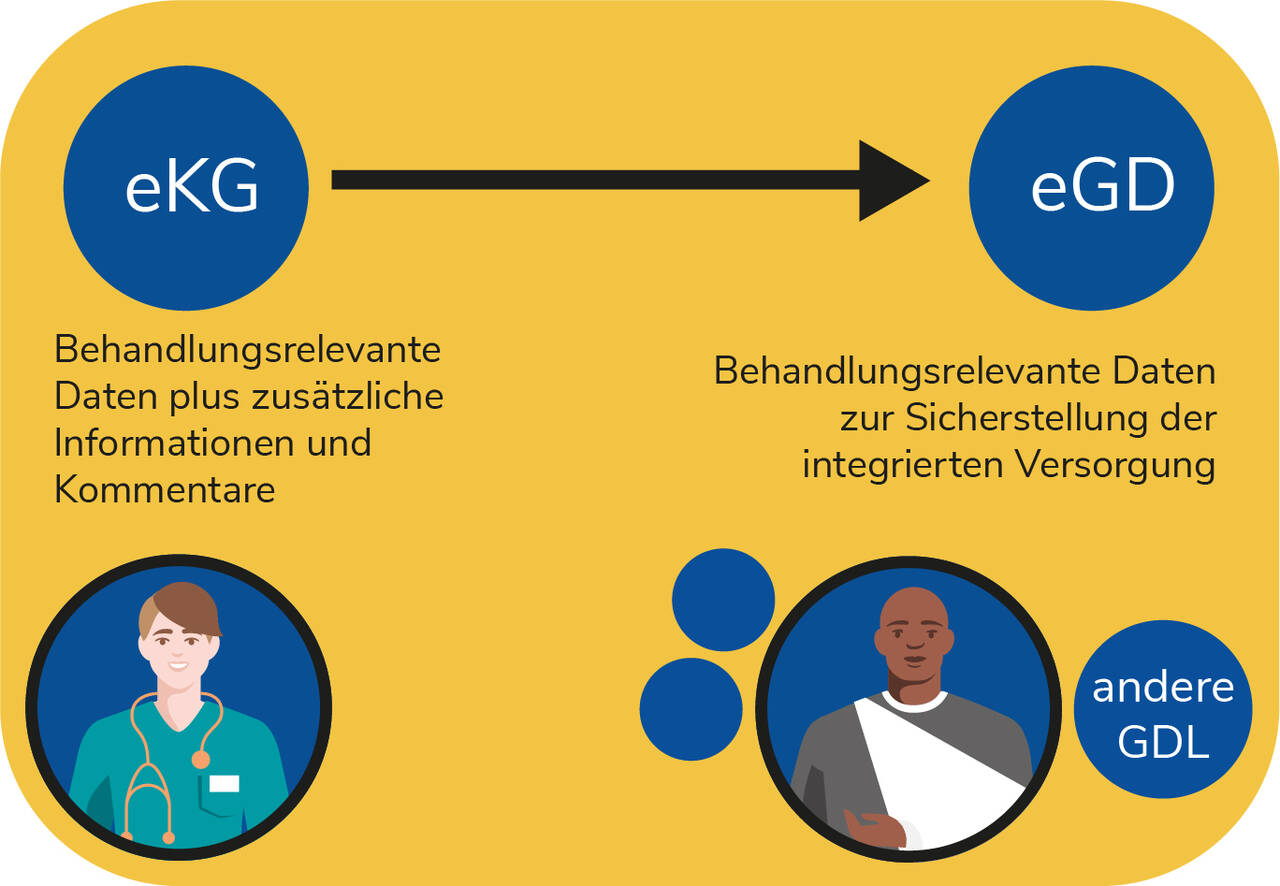Electronic Health Dossier (eGD)
Today, information about patients is scattered in many places, be it at the person to be treated himself, at various doctors' practices, at the hospital, at the pharmacy, at the nursing home, etc.. As a result, they are not available regardless of time and place. Modern eHealth solutions, in particular the so-called electronic health dossier (eGD), solve this problem and at the same time help to minimize risks (e.g. in connection with medication incompatibilities) as well as to eliminate diagnostic errors and duplications in treatment.
more less
The eGD is a collection of predefined medical data and information such as doctor's reports, laboratory findings, X-rays, vaccination data and medication lists. But important information such as allergies and intolerances can also be stored in it. Technically speaking, this data collection is an electronic database.
For every person with health insurance in Liechtenstein, an eGD is provided by the Liechtenstein National Administration. Medical data and information relevant to treatment are stored in the eGD by health care providers, so that the person with health insurance can release the stored information to other health care providers at any time.
The solution used in Liechtenstein is an established eHealth platform, which is used by Siemens Healthineers in many countries, in particular also in Austria (under the name "ELGA: Electronic Health Record) and in Switzerland (in cooperation with the Swiss Post AG) and is used by thousands of people every day.
Video: Siemens Healthineers
The solution complies with various international standards (e.g., IHE, HL7, DICOM) with the goal of standardizing and harmonizing the exchange of data between healthcare IT systems.
At the same time, the solution allows adaptation ("customizing") to Liechtenstein needs, e.g. with regard to the application of the eID for the authentication of persons with health insurance and healthcare providers.
An advantage of such a solution is also that Liechtenstein can benefit from further developments, which Siemens Healthcare will make anyway due to its international orientation with local presence in more than 70 countries worldwide.

This obligation to upload documents to the eGD affects, according to EGDG:
- Physician practices
- Land hospital
- Laboratories
- Pharmacies
- Dental practices
- Chiropractors
The documents to be uploaded according to EGDG are:
- Referral letters and physician reports
- Referral letters and discharge reports
- Laboratory findings
- Diagnostic imaging findings
- Medications
The upload of documents is not optional. Participants may object to the use of the eGD, in which case documents cannot and need not be uploaded. The objection cannot be declared to the health service provider, but can be entered by the participant him/herself after logging into the portalwith eID.li or declared to the health office. More information about the appeal can be found here
The patient data you collect electronically as a healthcare provider (eKG) forms the basis for the eGD.

On the one hand, the eGD is intended for the person with health insurance, so that he or she can view reports and findings at any time and check the current medication schedule or vaccination status. On the other hand, the eGD also contains information that may be of interest to other health care providers in a specific context - always with the consent of the person with health insurance. For example, if family doctors want to send patients to orthopedics for further examinations, their medical report or an X-ray image can be placed in the eGD. Doctors can also list the medications patients are taking so that the orthopedists are aware and can avoid medication incompatibilities as far as possible. However, the orthopedists can of course only access this data in the eGD with the consent of the person with health insurance.
This aspect of the dossier complements the so-called directed communication between health care providers, as is necessary to ensure integrated care. It should be noted at this point, however, that the eGD is not a complete copy of all eKGs. The eGD is a sum of individual treatment-relevant parts of different eKGs. It only contains health data that may be relevant for other service providers. It is at the discretion of each service provider to decide which data are relevant to treatment and are transferred to the eGD and which are not. In the eKG, as today, you can store additional information and comments, which will remain accessible only to you in the future.
As a healthcare provider, you are required by law to store treatment-related data in eGD as of or as of July 2023.
Depending on the practice information system, this involves some effort. Depending on the practice information system, costs (initial outlay/licenses) may be incurred for connection to the eGD. However, these costs will be moderate for modern systems.
At the same time, you as a healthcare provider can benefit from the solution, because in the future you will have easy access to data and information about a person with health insurance, which has been collected in advance by other healthcare providers. The benefits and simplification for all stakeholders involved will depend a priori on how widely and consistently the solution is used.
We will be happy to keep you informed about the connection to eGD through targeted newsletters to health care providers.
Duties
Certain health care providers are obliged to file medical data and information in the case of treatment in the eGD of the person with health insurance (Art. 19 para. 2 EGDG; Art. 5 para. 2 EGDG ). This includes doctors, the Liechtenstein National Hospital, the Liechtenstein Old Age and Sickness Assistance, pharmacies, chiropractors, dentists and other health care institutions as defined by the Health Act (e.g. medical laboratory) (Art. 2 para. 2 let. c EGDG). However, this obligation naturally only applies if the insured person has not objected to the use of the eGD (Art. 6 EGDG).
Rights
Inversely, these health care providers have the right to retrieve and view data and information from the eGD in the event of treatment, provided that the person with health insurance has consented to such access. However, depending on the healthcare service provided, only certain data and information can be viewed. For example, aphotechnicians only have access to medication data, but not to more extensive data and information in the eGD.
As a health care provider, you may only access the eGD in the case of treatment and if the person with health insurance has granted access accordingly. In case of emergency, you can access the eGD as a health care provider even if the insured person has not given you access rights or cannot give them at the moment. However, every access is logged (even outside of an emergency) and can be viewed directly in the eGD at any time by the person with health insurance. In the event of unjustified access, the person with health insurance can take legal action.
More questions and answers will be posted here successively.